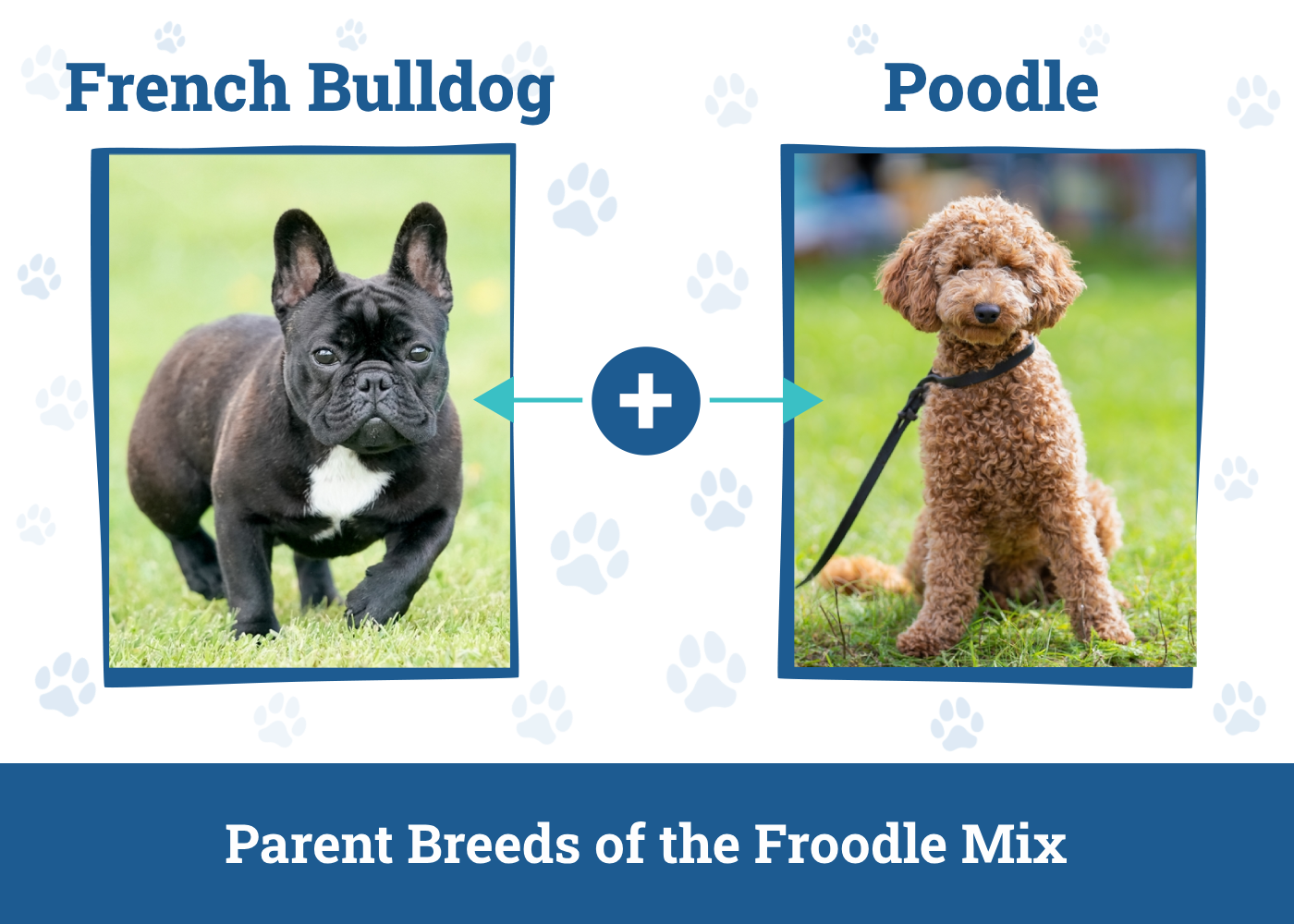In this article
View 8 More +The Froodle is a mixed breed dog that combines the French Bulldog and Poodle breeds. It is recognized by the American Canine Hybrid Club and is considered a lively, playful, loving companion dog. Although typically clever, the Froodle can be a little stubborn, which means training requires consistency and patience to get the best results.
They do demand a lot of attention, and this can manifest as separation anxiety if the dog is left alone for long periods, so it may not be the best choice of breed for owners who go out to work all day. Health issues are more prominent in Froodles that adopt the French Bulldog’s brachycephalic facial features, but the hybrid is generally considered a hardy little breed of dog.
Breed Overview
Height:
12–15 inches
Weight:
18–22 pounds
Lifespan:
11–13 years
Colors:
White, gray, black, tan, brown, beige, red
Suitable for:
Families and individuals with time and patience, looking for a loyal companion
Temperament:
Loyal, Loving, Affectionate, Intelligent, Stubborn, A Little Needy
The Froodle is a hybrid or mixed breed dog and the exact temperament and physical appearance of the dog will depend on which parent breed it tends towards. But, in either case, you can expect an affectionate and loving little family dog.
If your Froodle is closer to the Poodle parent, it will be less prone to stubbornness, although this attribute of the French Bulldog is likely to come through at least a little so consistent and fair training will be necessary to help get the best out of the dog.
However, with good training, the Froodle can go on to excel at agility and other canine sports and activities. The small dog can adapt to life in an apartment easily, and with good training and careful socialization, they will get along with children and other dogs in the house.
Froodle Characteristics

Froodle Puppies
The Froodle is a mixed breed, and as such it is not recognized by kennel clubs as it is not a purebred. Although fairly popular, it can still be difficult to find Froodle breeders, and it will take some effort to track down reputable ones in your area. Check online, speak to other owners, and consider checking with the American Canine Hybrid Club to see if they have details of any Froodle breeders in your area. When you do find a breeder, arrange a visit and meet the puppy and its Mom. Ensure both look healthy and that the dogs are kept in sanitary conditions. Ideally, they should be in the house so they can get human interaction other than when prospective buyers come to shop.
Alternatively, you can take a look at local rescues and shelters. Some might have Froodles or similar hybrid breeds. Adopting is a great way to provide a loving home for a dog in need and it also means that your new dog will be spayed or neutered and microchipped. Get as much detail about the dog as possible from the rescue, but bear in mind that a lot of owners miss out on details and lie when relinquishing their dogs, so you may not be able to get the full picture.
Ensure you start socializing and training your Froodle puppy as soon as you get it home. The breed can be a little bit prone to nipping if it hasn’t had this early training, so it will pay dividends in the long run.
Froodle Dog Breed Origin & History
There isn’t a lot of history specific to the Froodle, but both parent breeds are well-known and have well-documented histories.
Despite its name, the French Bulldog first originated in England in the 19th Century when it was bred from English Bulldogs to be smaller, companion variants of the breed. It was then transported to France, with lacemakers, where these efforts continued and this is when it got its breed name.
Although many consider the Poodle a French dog, it is generally accepted that it was first bred in Germany. Poodles were used to retrieve downed waterfowl for hunters and the Miniature Poodle, which is used in the breeding of the Froodle, was especially popular in the 18th Century, with members of the royalty.


Temperament & Intelligence of the Froodle Dog Breed 🧠
The Froodle is a companion dog, rather than a working dog. They will enjoy spending as much time as possible with their humans and can suffer separation anxiety when left alone for long periods. However, just because the Froodle is a companion dog doesn’t mean it doesn’t benefit from being given tasks to perform.
The parent breeds, especially the Poodle, are intelligent dogs and they need mental stimulation to help pass the time and keep them busy. Find ways to get your new dog involved in activities, set aside time for training every day, and consider canine sports events like agility. Interactive toys can also help keep the Froodle’s mind active and help reduce anxiety when left alone.
The Froodle is a happy and playful little dog. It will usually get along with all family members including children and other pets, but early training will help curb the pup’s enthusiastic play and prevent nipping.
The breed is considered intelligent, although it can be stubborn, especially if it takes after the Frenchie. It is possible to overcome, or at least work with, this stubbornness, but it will mean consistent, persistent, fair training techniques. There will be occasions when the Froodle simply wants to ignore you, and this will mean being a little firmer. This doesn’t mean being physical or raising your voice and shouting, but it means working harder with training methods.
Are These Dogs Good for Families? 👪
The Froodle combines the Miniature Poodle and the French Bulldog: both of these breeds are considered good family dogs. They will get along with children and will enjoy playing with them, and they are usually quite understanding and forgiving. Although quite small, the breed isn’t especially fragile, but you should still teach children how to be respectful to the puppy.
Good socialization and training will also help ensure that the Froodle doesn’t become too nippy, which can be an issue with some. And because the breed is welcoming and accepting of new people, they will get along with friends and visitors, including your child’s friends.
Does This Breed Get Along with Other Pets? 🐶 😽
Similarly, the Froodle can normally get along with other animals, including dogs and cats, and including those in the same house, although it does depend on the other animals, too.
Take introductions slowly to help ensure that the two will get along. Start by keeping them physically separate but allowing them to see one another. You can use a stairgate for this, which will allow the animals to sit on either side. They will be able to see and even smell one another, but they will feel safe.
Once they can effectively ignore the other animal, let them in the same room but keep them separate initially. Have a leash on the dogs and, if you’re introducing a cat, ensure it has a viable escape route back to an area where it feels safe. Don’t push introductions. Let the pets take it at their own pace, and if there is any sign of aggression or non-acceptance, separate them and try again at a later time.
Never leave a dog unattended with a smaller animal while it is out of the cage.

Things to Know When Owning a Froodle
The Froodle is a small, sturdy dog and it may have the longer snout of the Poodle or the shorter snout of the Frenchie. Similarly, ears can be long and floppy or round and erect, depending on which parent breed is dominant in the mix.
They do get along with strangers as well as all family members and can usually be introduced to a household with existing pets. But, while the Froodle can make a great pet for a lot of potential owners, there is no such thing as an ideal breed for all people.
Food & Diet Requirements 🦴
The Froodle is a small dog and while it is lively, it doesn’t require excessive exercise, which means that it also has a relatively modest appetite. Dry food feeders should give the Froodle approximately one cup of high-quality kibble per day. This should be given in two or even three meals, in equal portions. With wet food, follow the instructions on the packaging.
Whatever food you give, be careful not to overfeed. The relatively small amount of food you give means that even a small variance in dietary provision can lead to your dog putting on excess weight. An overweight dog is more likely to suffer certain breathing and heart-related conditions, and it can be very difficult to get the weight off once it has been put on.
Treats can help you overcome the stubborn side of this breed when it comes to training, but you need to be careful not to overfeed. Treats should not make up more than a tenth of your dog’s daily calorie intake, and you need to adjust the amount of food you give according to the treats you offer.
Always ensure there is fresh drinking water available, 24 hours a day.
Exercise 🐕
The Froodle is lively, but it is small and doesn’t need an excessive amount of exercise. 45 minutes of walks a day should provide ample exercise. However, you can provide additional exercise in the shape of agility or other canine sports.
Agility classes and competitions are a good way to engage with your dog and build a bond between the two of you and they can also help with training.
Training 🎾
Training is important for all dogs. It sets boundaries and lets dogs know what is considered good behavior and what is unacceptable, as well as teaching some basic commands that will prove invaluable in the coming years.
The Froodle can be a little bit nippy and are prone to using their mouth. They don’t necessarily bite, but can nip, so early training should concentrate on discouraging this behavior. Encourage alternative behaviors like grabbing a favorite toy by rewarding that behavior while ignoring any nipping that does happen.
You will also want to teach the leave and down commands, with the latter being especially useful to prevent overactive greetings when your dog meets new people or other dogs.
Puppy classes are a good way to start your training journey together, and they can also help with socialization. Socialization means introducing your dog to new people and animals and teaching them that new situations are nothing to be afraid of. Socialization and training should continue throughout your dog’s life, but the first year is the most important. Early efforts enable you to lay the foundations for long-term success.
Grooming ✂️
Depending on which parent breed your Froodle is like, grooming can be easy or challenging. The Frenchie doesn’t need much in the way of regular grooming thanks to its short, smooth coat. The Poodle, however, needs daily brushing and regular grooming sessions. Brushing is also a good opportunity to look for signs of injury or illness.
Areas of the coat need regular trimming to ensure your dog is comfortable, and if you aren’t comfortable with this, you can visit a professional groomer and have them do it for you. Nails will need trimming typically every 2 months, and you should brush your dog’s teeth between three times a week and daily.
Health and Conditions ❤️
Because this is a hybrid breed, there is less chance of your dog developing certain hereditary conditions than if it were a purebred Poodle or French Bulldog, but there are still risks. If the Froodle has the brachycephalic facial features of the Frenchie, this can be especially problematic and may lead to eye and breathing problems.
- Eye Infections
- Patellar Luxation
- Diabetes
- Heart Defects
- Immune Mediated Hemolytic Anemia
- Progressive Retinal Atrophy

Male vs Female
The male Froodle is likely to grow a little larger and heavier than the female. Individual character, as well as history, training, and socialization, are more likely to determine the behavior traits of your dog, but there are some anecdotal reports of males being more likely to nip and be more playful, while females can be moody but less likely to suffer separation anxiety.

3 Little-Known Facts About the Froodle
1. French Bulldogs Can Be Very Noisy
The French Bulldog has a brachycephalic face, which means it has googly eyes and a short snout. These facial features make the breed instantly recognizable, but they can also lead to some potentially serious health defects that owners need to look out for.
2. Poodle Are Said to Be Hypoallergenic
One of the reasons for the Poodle’s popularity is that it is said to be hypoallergenic. Although no dog breed can be truly hypoallergenic, as they all produce the proteins that cause allergic reactions in sufferers, the Poodle doesn’t shed heavily, which means there is less dander, which is a common cause of reactions.
Your Froodle might adopt the Poodle coat, which means it might be a good choice for dog allergy sufferers.
3. The Froodle Can Suffer from Separation Anxiety
The Froodle loves its human family, which makes it a great companion dog breed. However, this devotion and desire to be with its people can also cause separation anxiety which means it can’t be left alone all day.

Final Thoughts
The Froodle is a mixed breed that combines the Miniature Poodle and the French Bulldog: two popular companion breeds. The resulting mixed breed is a friendly, amiable, loyal, loving dog, but it can be a little stubborn and might require extra training when you first get the dog.
It can also suffer separation anxiety if left alone for long periods, but it will get along with everybody, from family members to strangers, including four-legged guests.



















